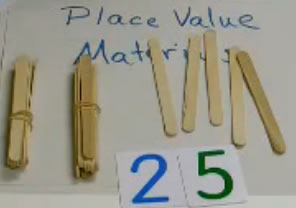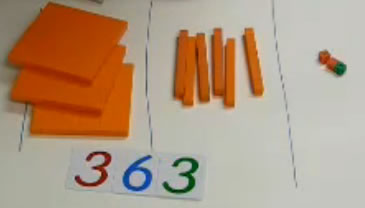Materials that students group themselves are called "decomposable" or "groupable" materials, because they can be grouped and ungrouped when it is convenient to do so.
Decomposable and/or Groupable materials have a lot of advantages for introducing the base 10 number system.
- Decomposable/Groupable materials are materials that conisist of objects that represent ones, and a system for grouping those objects into tens and the tens into hundreds.
- Decomposable and/or Groupable materials are particularly good for kindergarten and first grade.
- Base 10 work is explored somewhat in kindergarten, and it is a major focus of math in first grade.
- Children need lots of experience with grouping and ungrouping objects in tens as they make the transition from thinking of numbers as ones to thinking of numbers as tens and ones.

Pregrouped materials are base 10 materials where you can't physically take apart a ten to make 10 ones, and you can't physically take apart a 100 to make 10 tens. Working with pregrouped materials is somewhat more abstracgt than working with groupable materials, and it further reinforces the base 10 structure of numbers.
Proportional materials are base 10 materials where a ten is physically the same size as 10 ones, and a hundred is physically the same size as 10 tens. This helps children understand the place value relationships. Groupable materials are proportional, and so are many pregrouped materials
- The most common pregrouped proportional materials are Diens blocks, which are often called base 10 blocks. Base 10 blocks are made so that the size relationships between the place values are easy to see and compare.
- Work with pregrouped materials should come after work with groupable materials.
- Instead of grouping and decomposing, with pre-grouped materials, we have to trade or exchange amounts to make or break down tens.
- Children can productively repeat the same sorts of counting and number making exercises with pregrouped materials that they did earlier with groupable materials.
- Pregrouped materials are ideal for second grade and third grade, and when available, can also be productively used in first grade.

Non-Proportional materials are base 10 materials where the size of a ten is not the same as the size of 10 ones. Typically, a ten, a one and a hundred will all be the same size, and will be distinguished by numbers written on the material. An advantage of non-proportional materials is that you can easily work with larger place values without running out of room. It also helps with the transition to using only written numbers: non-proportional materials are more abstract than proportional materials, but are (for most purposes) more concrete that working only with written numbers.
- Non-proportional materials include chips, Montessori stamp game tiles and money (particularly coins).
- Non-proportional materials means that the value of the material is represented in a way that is different from size. It can be amounts of money for coins or a numerical value written on the chips or tiles.
- Non-proportional materials rely on childrens knowledge of trading and exchanging place value materials when representing numbers.
- When using coins to solve problems and represent numbers, it's appropriate to begin with only pennies, nickels and dimes, and add quarters significantly later (when children have mastered pennies, nickels and dimes).
- Non-proportional materials are more abstract than proportional materials, and should follow work done with proportional materials:
- Children can productively repeat the same sorts of counting and number making exercises with non-proportional materials that they did earlier with proportional materials.
- Work with non-proportional materials moves children further towards the abstraction of working with only numbers, rather than numbers and materials both.
- Children as young as second grade can work with non proportional materials effectively, but it should follow work with proportional materials. Non-proportional materials shouldn't replace proportional materials until (ideally) late third grade or fourth grade.
- Non-proportional materials are more convenient for work with larger numbers (especially thousands) because the problems require less space.
